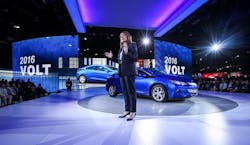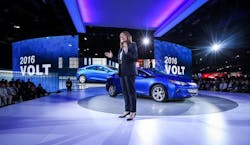“I believe the industry will experience more change in the next 5 years than it has in the last 50 years,” Barra (shown at right introducing the 2016 Chevrolet Volt earlier this year) said. “I don't make this claim lightly [as] I believe we are on the verge of a revolution in personal transportation.”
For example, she noted that today there are roughly 30,000 parts that make up the typical automobile – and virtually all of them are being reconsidered and reimagined.
“Every assumption and industry norm is being challenged: Different fuel sources; new propulsion systems; lighter, stronger materials; reduced environmental impact; connectivity preferences; even the right to drive in congested urban areas are just a few examples of the reinvention process that's underway,” she pointed out.
“It is impossible to overstate the magnitude of change I'm talking about,” Barra stressed.
One example of she pointed to of that “magnitude” is how the technology industry is becoming more engaged in automotive design and construction because “they realize that cars are the ultimate mobile app.”
That is one reason why GM is now equipping 30 of its models with 4G LTE, which includes a built-in Wi-Fi hot spot capable of pairing up to seven devices.
As an aside, another factor in all of this change is the makeup of the engineering base GM is drawing upon – nearly 37,000 strong, if you can believe it – which includes a significant number of female engineers in charge of making many of the newfangled systems being placed into cars and trucks work smoothly.
It starts at the very top as Barra herself is an engineer by training, which may be one reason GM is so focused on “non-traditional” vehicle technology these days.
“As an engineer, I am trained to focus on facts and data. In the world of science and math, ambiguity is the enemy,” Barra said in her speech. “I always want to know the facts and I believe in measuring outcomes. To that end, we know that our processes and systems have to produce superior results. And our technology solutions have to meet and exceed consumer expectations.”Meeting such expectations is the responsibility of engineers like Jessica Moreno (seen at left with her two children), GM's program manager for V2V [vehicle-to-vehicle] security credential management.
Her job is at once simple and frightening complex: ensure that vehicles can share information about traffic jams or crashes in a secure fashion without fear of hacking.
In fact, the 2017 Cadillac CTS sedan is expected to be the first vehicle in the U.S. to implement V2V technology, Moreno noted in a separate statement.
“The software that we’re developing helps certify that a vehicle is a trusted and reliable source of information thereby allowing it to communicate with other vehicles on the road,” she explained.
Then there’s Trista Schieffer, GM’s lead development engineer for battery electric vehicles.
While gasoline-powered cars remain the top sellers, GM continues to work on a variety of all-electric vehicles (EVs) such as the Chevrolet Volt, Spark EV, Cadillac ELR and the forthcoming battery-power car based on the Chevy Bolt. In addition to extended-range electric and pure EV, technologies include start-stop, eAssist and hybrid.And she is the engineer responsible for making sure everything works together seamlessly.
“I love problem solving,” Schieffer (at right) said. “I collaborate with people to deliver efficient solutions to solve ride, handling, noise, vibration, comfort, storage, heating, cooling, safety, energy efficiency – all aspects of a vehicle. Together we make sure the parts and systems are integrated so the vehicle performs in the manner our customers anticipate. As vehicles rely less and less on traditional fuel systems – or, in certain cases, not at all – we face new challenges.”
And not just in terms of propulsion. Barra aid when one thinks about autonomous vehicles (AVs), so-called “self-driving cars,” one realizes just how much technology will be required to make function safely and smoothly day in and day out until they are taken for granted.
“The most important point you should remember about AVs is that they are coming – and fast,” Barra stressed. “The technological foundation for autonomous vehicles can be seen in cars today - adaptive cruise control, lane changing warnings, front and rear cameras, to name just a few.”
In less than two years, GM is going to start connecting cars to each other via a V2V system noted above using wireless technology the company is calling V2X.
“V2X encompasses both vehicle-to-vehicle and vehicle-to-infrastructure technology,” Barra explained. “It's a game changer for safety, because when enough cars share information about such factors as speed, direction, and braking, crashes will be substantially reduced. This is reality. It is not science fiction. It is not a pipe dream. It is here. We know how to do it. And it will transform the industry in the coming years.”
While building the communication infrastructure will certainly take time, as will getting buy-in from the politicians and the public alike, Barra thinks the savings in accidents, economic loss, congestion, environmental impact – plus, most significantly, in injuries and fatalities – will be “extraordinary.”
Indeed, GM is currently working with the state of Michigan and the University of Michigan to create more than 100 miles of V2X-enabled corridors in the Detroit area to test this technology out thoroughly.
“Just think what we can do with a world of safer vehicles, with vehicles that also use less fuel, that have less environmental impact, that are programmed to prevent accidents and reduce congestion,” she said.
It’s a pretty amazing series of thoughts, actually. Yet we remain at the moment only at the beginning of this technological “revolution” for a whole lot of work still needs to be done to make it all work like an afterthought in our daily lives.
Stay tuned.



